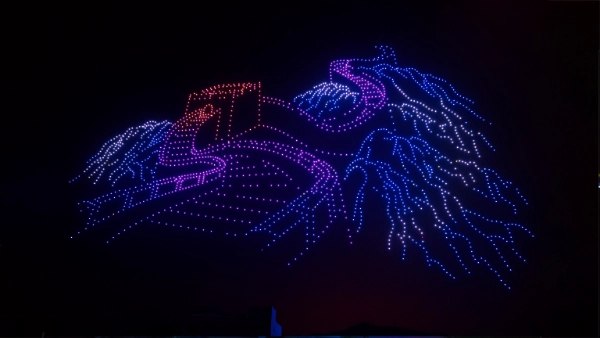Daily Maintenance of Outdoor Drone for Light Show
In recent years, drone light shows have rapidly gained popularity for their ability to transform the night sky into a canvas of synchronized illumination, choreography, and storytelling. These displays rely heavily on large fleets of outdoor drones, operating in tightly coordinated formations. In this blog post, Highgreat, as a high performance drones for outdoor use manufacturer, will share the daily maintenance of outdoor drone for light show, which will help extend the life of the equipment and ensure its consistent excellent operation.
1. Importance of Outdoor Drone for Light Show Maintenance
Drones used in outdoor light shows face unique challenges. They are frequently exposed to fluctuating weather conditions, high-frequency flight schedules, and the stress of mass formation maneuvers. Unlike recreational or commercial drones with occasional usage, light show drones often perform several flights in one evening, across multiple days of an event.
Without proper and regular inspection and servicing, minor issues - such as a misaligned propeller or dust in the motor - can escalate into performance failures, threatening safety and the success of the entire show. Daily maintenance not only ensures individual drone health but also preserves formation integrity.
2. Pre-Flight Maintenance Checklist
Before each deployment, every drone should go through a structured checklist to detect faults early.
a. Visual Inspection
* Frame & Arms: Check for any visible cracks, bends, or deformation.
* Propellers: Examine each blade for nicks, chips, or warping. Damaged propellers can destabilize flight paths.
* LED System: Ensure all lights are securely attached and fully functional.
b. Motor and Rotor Examination
* Rotate motors by hand to check for resistance or abnormal noise.
* Clear any dust, debris, or grass from motor vents.
* Confirm that motor mounting screws are tight and secure.
c. Battery Condition
* Measure battery voltage and temperature before flight.
* Inspect for bloating, discoloration, or leakage.
* Ensure all connectors are free of corrosion and securely attached.
d. Firmware and Communication
* Confirm that firmware on flight control and light control modules is updated.
* Check GPS lock and IMU calibration.
* Ensure that drone IDs, frequency channels, and show routines are correctly assigned.

3. Post-Flight Maintenance Protocol
Daily maintenance should continue immediately after flight, especially after outdoor exposure.
a. Surface Cleaning
* Use a soft brush or air blower to remove dust and moisture.
* Wipe down body surfaces with a dry microfiber cloth.
* Clean lens or diffusers on the LED systems to preserve brightness and color integrity.
b. Battery Re-Check and Management
* Allow batteries to cool naturally before charging.
* Log flight time and power draw for trend monitoring.
* Store batteries in fireproof cases and under recommended voltage levels (typically 3.7–3.85V per cell).
c. Propeller and Arm Check
* Re-inspect props for post-flight wear.
* Re-tighten all screws and mounts.
* Replace any parts showing fatigue.
d. Flight Log Review
* Use flight data to check for anomalies in height, drift, or power consumption.
* Identify underperforming units for deeper inspection.
* Update maintenance logs with any replacements or calibrations done.
4. Environmental Considerations
Outdoor drones must be maintained with environmental exposure in mind.
* Dust & Sand: In desert or festival environments, intake vents and motor housings can become clogged. Daily air blasting and protective mesh usage are recommended.
* Humidity & Rain: After exposure to moisture, all drones should be thoroughly dried. Desiccant storage containers can help absorb residual humidity.
* Cold Weather: Check for battery heating systems and ensure batteries are above operating temperatures (15°C) before takeoff.
5. Software & Communication Integrity
Light show drones rely on tight synchronization across fleets - any communication lag or ID conflict can cause mid-air collisions or choreography failures.
* Re-confirm show sequences are uploaded properly.
* Run a brief indoor or limited test flight to verify sync response.
* Check that drone-to-ground station communication strength is within normal range.
6. Team Workflow and Record Keeping
Efficient daily maintenance requires coordination:
* Assign drone technicians specific batches (e.g., 20 drones per person).
* Maintain a Daily Health Record Sheet tracking:
Flight hours
Battery cycle count
Replaced parts
Firmware versions
* Use QR code systems for quick drone identification and maintenance logs.
7. Preventive vs. Reactive Maintenance
By committing to daily upkeep, operators shift from a reactive (fix-when-broken) mindset to a preventive maintenance strategy, which:
* Reduces unexpected failures during a live show.
* Improves fleet longevity.
* Minimizes the need for emergency backups or show cancellations.
Conclusion
Daily maintenance of outdoor drones for light shows is not an optional task - it is a professional obligation. These high-precision aircraft operate in tightly choreographed displays, where even a small deviation can compromise an entire performance. Through structured pre- and post-flight checks, environmental cleaning, battery care, and diligent logging, operators can ensure that their drone fleets remain in peak condition.
For drone manufacturers and service providers alike, investing in comprehensive daily maintenance workflows not only ensures safety and performance - it reinforces brand reputation in a rapidly expanding and visually spectacular industry.

 Telephone No.Email
Telephone No.EmailMailbox number:marketing@hg-fly.com



